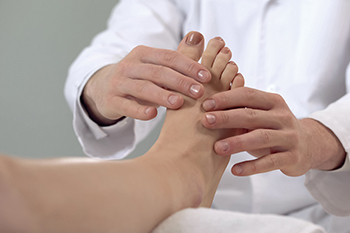Dallas (214) 340-8885
Athens (903) 677-9090
Gun Barrel City (903) 887-4341
Dallas (214) 340-8885
Athens (903) 677-9090
Gun Barrel City (903) 887-4341

There are many bones located in the foot that each play an important role in helping the foot function and move properly. The cuboid bone is one such bone. Located on the outer side of the foot in the midfoot area, this small bone is almost cubical in shape. It is critical to the foot because not only does it provide stability, it also facilitates sufficient weight distribution throughout the feet. It is important to note that the cuboid bone additionally aids in toe movement. A number of ligaments are also attached to the cuboid bone, including the birfurcate ligament and the cuboideonavicular ligament. The cuboid bone alone does not usually fracture by itself in the foot. However, it is susceptible to a condition known as cuboid syndrome, which can move the bone out of alignment. If you want to learn more about the cuboid bone, make an appointment with your local podiatrist today.
If you have any concerns about your feet, contact Dr. Jonathan Kletz from Texas Foot Works. Our doctor can provide the care you need to keep you pain-free and on your feet.
Biomechanics in Podiatry
Podiatric biomechanics is a particular sector of specialty podiatry with licensed practitioners who are trained to diagnose and treat conditions affecting the foot, ankle and lower leg. Biomechanics deals with the forces that act against the body, causing an interference with the biological structures. It focuses on the movement of the ankle, the foot and the forces that interact with them.
A History of Biomechanics
Modern technological improvements are based on past theories and therapeutic processes that provide a better understanding of podiatric concepts for biomechanics. Computers can provide accurate information about the forces and patterns of the feet and lower legs.
Understanding biomechanics of the feet can help improve and eliminate pain, stopping further stress to the foot.
If you have any questions please feel free to contact one of our our offices located in Dallas, Athens, and Gun Barrel City, TX . We offer the newest diagnostic and treatment technologies for all your foot and ankle needs.

The forefoot is a third of the foot which is closest to the toes. Pain in this area, sometimes referred to as metatarsalgia, often centers on the ball of the foot and the toes. Causes include bunions or other misalignment of the toes, rheumatoid arthritis, or a buildup of calluses. Another common cause is sesamoiditis, an inflammation of two tiny bones near the toes, called sesamoids. This is often seen in dancers, runners, and athletes who apply pressure when flexing the toes. Morton’s neuroma is another cause, which damages nerves that run between the toes. Pain and a burning sensation from this condition is generally located between the 3rd and 4th toes. This is more common in women, especially those who wear high heels with pointy toes. Being overweight, stress fractures, and high arches can also contribute to metatarsalgia. Forefoot pain usually gets worse when walking, standing, and running, or when the foot is flexed. To have your forefoot pain properly diagnosed, please visit a podiatrist.
Foot Pain
Foot pain can be extremely painful and debilitating. If you have a foot pain, consult with Dr. Jonathan Kletz from Texas Foot Works. Our doctor will assess your condition and provide you with quality foot and ankle treatment.
Causes
Foot pain is a very broad condition that could be caused by one or more ailments. The most common include:
Diagnosis
To figure out the cause of foot pain, podiatrists utilize several different methods. This can range from simple visual inspections and sensation tests to X-rays and MRI scans. Prior medical history, family medical history, and any recent physical traumatic events will all be taken into consideration for a proper diagnosis.
Treatment
Treatment depends upon the cause of the foot pain. Whether it is resting, staying off the foot, or having surgery; podiatrists have a number of treatment options available for foot pain.
If you have any questions, please feel free to contact one of our our offices located in Dallas, Athens, and Gun Barrel City, TX . We offer the newest diagnostic and treatment technologies for all your foot care needs.

There are various professions that require standing for the majority of the day. These include retail workers, medical field personnel, and restaurant employees. Research has indicated that many people who endure standing have chronic foot pain. The feet carry the weight of the body, and it is not surprising that foot pain exists. A common foot condition that can be caused by standing all day is plantar fasciitis. This affects the heel and the arch of the foot, and it can cause difficulty in walking. This condition often requires attention sooner than later, relief may be relieved by wearing custom-made orthotics. The feet distribute the weight of the body unequally, as most people alternate their weight between their feet. This can cause overall muscle fatigue, and general discomfort. Additionally, this can negatively affect an employee's performance, as the days are spent in pain. It is beneficial to stand on a stress mat that may help to balance the body’s weight, in addition to wearing comfortable shoes. If you have questions about how to protect your feet while standing all day, please consult with a podiatrist who can address any concerns you may have.
While working on the feet, it is important to take the proper care of them. For more information about working on your feet, contact Dr. Jonathan Kletz from Texas Foot Works. Our doctor will treat your foot and ankle needs.
Working on Your Feet
Standing on your feet for long periods of time can cause stress and pain in your feet. Your whole body may experience change in terms of posture, back pain, bunions, callouses and or plantar warts. There are ways to avoid these conditions with proper foot care, smart choices and correct posture.
Positive Changes
Negative heeled shoe – Choosing this shoe type places the heel slightly lower than the ball of the foot. These are great for overall foot health. Find shoes that fit you correctly.
Go barefoot – Our feet were not designed to be enclosed for all hours of the day. Try to periodically expose your feet to air.
Eliminate Pain
Foot Exercises – Performing simple exercises, incorporating yoga and doing stretches are beneficial. This will allow increased blood flow to the area and muscles of the foot.
Achilles tendon – Stretching the foot out flat on the floor will relax the calf muscles and tendon. These exercises can be performed almost anywhere. Make sure you add these exercises to your daily regimen.
With a little bit of this information and knowing more about foot health, you will notice changes. Foot stretches and proper footwear will help with pain and prevent further issues.
If you have any questions please feel free to contact one of our our offices located in Dallas, Athens, and Gun Barrel City, TX . We offer the newest diagnostic and treatment technologies for all your foot and ankle needs.

When a child has flat feet, it means that the foot arch is absent. This condition, known as falling arch or pes planus, is common in children until their foot takes shape as they grow up. Kids have loose joint ligaments. At about 2 to 3 years of age, their arch becomes visible and continues developing until a proper arch is formed in adolescence. This problem typically occurs in one foot. After age 3, one can usually recognize that a child has flat feet. If it is hard to see, the foot can be dipped in ink or water and when standing, placed on a piece of paper or some other surface where the impression can be seen. Flat feet can be hereditary, caused by complications in the womb, fused bones, baby fat between the foot bones, injuries, or from the joint between two bones being very loose in small babies. Children usually do not face any problems with this issue. However, if a child has pain or fatigue when taking long walks, or if the child walks with a limp, it is suggested that you contact a podiatrist to have their feet examined and treatment provided.
Flatfoot is a condition many people suffer from. If you have flat feet, contact Dr. Jonathan Kletz from Texas Foot Works. Our doctor will treat your foot and ankle needs.
What Are Flat Feet?
Flatfoot is a condition in which the arch of the foot is depressed and the sole of the foot is almost completely in contact with the ground. About 20-30% of the population generally has flat feet because their arches never formed during growth.
Conditions & Problems:
Having flat feet makes it difficult to run or walk because of the stress placed on the ankles.
Alignment – The general alignment of your legs can be disrupted, because the ankles move inward which can cause major discomfort.
Knees – If you have complications with your knees, flat feet can be a contributor to arthritis in that area.
Symptoms
Treatment
If you are experiencing pain and stress on the foot you may weaken the posterior tibial tendon, which runs around the inside of the ankle.
If you have any questions please feel free to contact one of our our offices located in Dallas, Athens, and Gun Barrel City, TX . We offer the newest diagnostic and treatment technologies for all your foot and ankle needs.